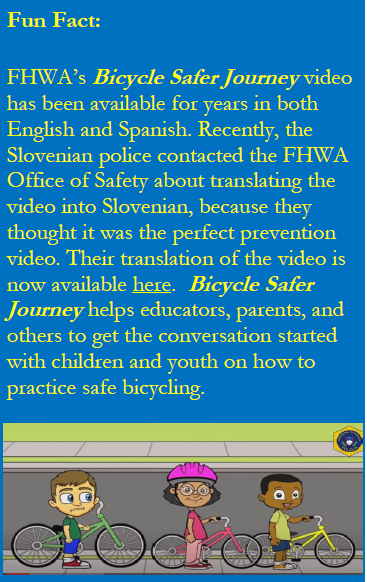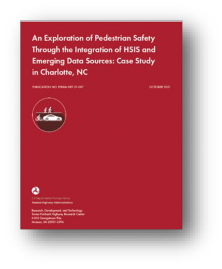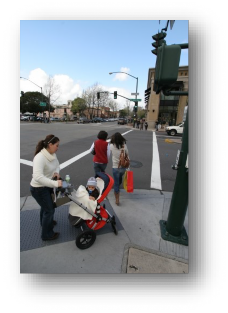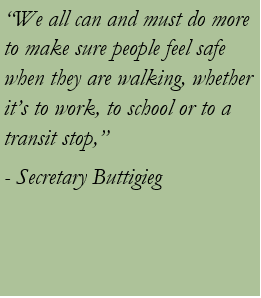U.S. Department of Transportation
Federal Highway Administration
1200 New Jersey Avenue, SE
Washington, DC 20590
202-366-4000


U.S. Department of Transportation
Federal Highway Administration
Downloadable PDF [0.94 MB]
In this issue:
FHWA Updates List of Proven Safety Countermeasures
FHWA Updates List of Focus States for Pedestrians and Bicyclists
Safe Transportation for Every Pedestrian
Coming Soon! Improving Safety for Pedestrians and Bicyclists Accessing Transit
Updated Pedestrian and Bicycle Crash Analysis Tool
The Federal Highway Administration (FHWA) Office of Safety recently completed its third update to the list of countermeasures proven to increase safety. In October 2021, nine NEW countermeasures (including three for pedestrians and bicyclists: Rectangular Rapid Flashing Beacon, Crosswalk Visibility enhancements, and Bicycle Lanes) were added to the Proven Safety Countermeasures initiative (PSCi). This list of Proven Safety Countermeasures (PSCs) has now reached a total of 28 treatments and strategies that practitioners can implement to successfully address roadway departure, intersection, and pedestrian and bicyclist crashes. Among the 28 PSCs are several crosscutting strategies that address multiple safety focus areas.
FHWA created the PSCi in 2008 as part of the "Guidance Memorandum on the Consideration and Implementation of Proven Safety Countermeasures," which highlights when and where agencies should implement certain countermeasures.
Widespread implementation of PSCs, where appropriate, can help local, State, and national agencies achieve safety goals.
In addition to the nine new countermeasures and crosscutting strategies, this most recent iteration of the PSCi adds recent research and considerations to the existing PSC materials. FHWA added new features to the PSC website, including a filter tool and search function that will help practitioners identify applicable countermeasures that meet their needs. The updated PSC website is the one-stop shop for resources and information to advance the 28 countermeasures.
For more information or assistance, please contact phillip.bobitz@dot.gov. FHWA is promoting the eight countermeasures in the graphic below to address pedestrian and bicyclist safety.


Since 2004, FHWA's Office of Safety has been working to aggressively reduce pedestrian deaths by focusing extra resources on the cities and States with the highest pedestrian and bicyclist fatalities and/or fatality rates. Bicyclists were added to the Focused Approach in 2015 and the initiative is known as the Pedestrian and Bicycle Safety Focus States and Cities.
FHWA updates the list of States and focus locations every 4 to 5 years, so in 2021 FHWA completed the most recent update of the Focused Approach to Safety Initiative. FHWA summarized the noteworthy changes in an October 20, 2021,memorandum and also explained the updates in a recorded webinar.
Some of the changes implemented in 2021 include the following:

Recently, FHWA published An Exploration of Pedestrian Safety Through the Integration of HSIS and Emerging Data Sources: Case Study in Charlotte, NC. The report details FHWA' s geospatial pilot effort, which used data from Charlotte, NC available in the Highway Safety Information System (HSIS). The report explored spatially integrating HSIS data with multi- jurisdictional and emerging datasets to analyze two measures of pedestrian safety performance: the severity of a pedestrian crash that has occurred, and the probability that a pedestrian crash will occur.
The report also discussed several high- priority research topics in safety data and analysis, including pedestrian crash analysis, probe data integration and analysis, and geospatial HSIS data integration. Results showed that higher pedestrian volumes resulted in both lower crash severities and probabilities, but the safety benefit was reduced by higher vehicle volumes. Higher speeds, higher traffic volumes, larger vehicles striking the pedestrian, pedestrian impairment, and older pedestrian ages were all indicative of higher probabilities of a pedestrian crash resulting in a fatality or serious injury.
For more information, please contact Ana Maria Eigen, D.Sc., HSIS Program Manager.

FHWA invites you to be our Most Valuable Player (MVP) for Pedestrian Safety. Pedestrians face many challenges, from locating a crosswalk, to navigating many lanes when crossing.
In FHWA’s latest video, join Coach Peter as he asks viewers to think of pedestrian safety like a sport’s field. Come learn the plays and how the Safe Transportation for Every Pedestrian (STEP) innovations improve pedestrian safety. Be a part of a winning team - Save Lives! Pedestrian Safety is No Game.

The National Highway Traffic Safety Administration (NHTSA) and FHWA celebrated National Pedestrian Safety Month in October 2021 and strengthened their efforts to improve safety for vulnerable road users. NHTSA released a new Resource Guide which includes sample social media posts and messaging, facts and information, and other available resources focused on safe people, speeds, roads, vehicles, and post- crash care that can be used year-round.
U.S. Transportation Secretary Pete Buttigieg, NHTSA's Deputy Administrator Dr. Steven Cliff, and FHWA's Deputy Administrator Stephanie Pollack reiterated the importance of working together to improve safety for people who walk and bike. “We all can and must do more to make sure people feel safe when they are walking, whether it’s to work, to school or to a transit stop,” said Secretary Buttigieg. “We must all work together to prevent and eliminate crashes leading to serious injuries and deaths of our nation’s pedestrians,” added Dr. Cliff. Ms. Pollack emphasized “All of us - State and local transportation agencies, planners and road designers, drivers and safety advocates - can contribute to improving safety for people who walk and roll.”
Recognizing that reliably detecting pedestrians and cyclists as one of the toughest technical challenges that fully autonomous vehicles face, Partners for Automated Vehicle Technologies held a virtual panel “How Do AVs See Pedestrians?” The Institute of Transportation Engineers highlighted its public agency members’ efforts that demonstrate the increased emphasis on pedestrian safety.
Across the Nation, State DOTs, State Highway Safety Offices, private and public organizations, associations, and companies took part in National Pedestrian Safety Month. In October, 48 States and the District of Columbia hosted 2,600 Walk to School Day events. In Maryland, October became Walktober, where the Maryland DOT and other partnering agencies promoted and hosted events and webinars spotlighting Maryland pedestrians’ safety, health, and commuting options in current walk programs and initiatives.
For more information and available traffic safety materials visit: https://www.trafficsafetymarketing.gov/get-materials

![]() FHWA’s upcoming Improving Safety for Pedestrians and Bicyclists Accessing Transit guide builds on the 2008 FHWA publication, Pedestrian Safety Guide for Transit Agencies. Since the guide’s publication in 2008, some aspects of transit have stayed the same: Public transportation provides people with mobility and access to employment, community resources, medical care, and recreational opportunities in communities across America. It benefits those who choose to ride, as well as those who have no other choice. Other aspects of using and accessing transit - including the types of modal choices available at our fingertips - have changed drastically.
FHWA’s upcoming Improving Safety for Pedestrians and Bicyclists Accessing Transit guide builds on the 2008 FHWA publication, Pedestrian Safety Guide for Transit Agencies. Since the guide’s publication in 2008, some aspects of transit have stayed the same: Public transportation provides people with mobility and access to employment, community resources, medical care, and recreational opportunities in communities across America. It benefits those who choose to ride, as well as those who have no other choice. Other aspects of using and accessing transit - including the types of modal choices available at our fingertips - have changed drastically.
This guide is intended to not only reflect those changes, but also address the safety of a variety of vulnerable road users, such as pedestrians, bicyclists, and micromobility users, who are similarly susceptible to severe injury or fatality if involved in a crash.
Agencies should consider the needs of all users when thinking about how to improve safe access to transit. This guide contains specific considerations about how agencies can help to make sure that all people: 1) are considered, 2) feel safe and welcomed accessing these facilities, and 3) can have the confidence that these spaces were planned and designed with them in mind. This guide is intended for transit agencies, State and local roadway owners, and regional organizations involved with planning and designing transit stops and the roadway, pedestrian, and bicycle facilities that provide access to transit.
The guide will be available later this year. Sign up on FHWA’s electronic subscription page to get updated once it is available on the web. You also can sign up to get notified of future updates for the Pedestrian and Bicyclist Safety Program and a variety of other topics of your choosing.

FHWA has released version 3 of the Pedestrian and Bicycle Crash Analysis Tool (PBCAT). PBCAT is a crash typing software product intended to assist State and local pedestrian/bicycle coordinators, planners, and engineers with improving walking and bicycling safety. The product is designed to help road safety professionals improve their understanding of non-motorist crashes. Through development and analysis of a database containing details associated with crashes between motor vehicles and pedestrians or bicyclists, transportation professionals can make their systems safe.
One of these crash-associated details is crash type, which describes the pre-crash actions of the involved parties. After developing a database of crash information from PBCAT output, the user can analyze the data to produce reports and help select countermeasures to address problem areas. The application also allows users to categorize their non-motorist crashes and create a data set for analysis. Version 3 is available online, free through the HSIS webpage. The updated version also features new graphics, logic, and considers micromobility in its analysis. The accompanying User Guide provides detailed information on how to use PBCAT.
Agencies should consider the needs of all users when thinking about how to improve safe access to transit. This guide contains specific considerations about how agencies can help to make sure that all people: 1) are considered, 2) feel safe and welcomed accessing these facilities, and 3) can have the confidence that these spaces were planned and designed with them in mind. This guide is intended for transit agencies, State and local roadway owners, and regional organizations involved with planning and designing transit stops and the roadway, pedestrian, and bicycle facilities that provide access to transit.
For more information, please contact Carol Tan at Carol.Tan@dot.gov.

Tamara Redmon, Pedestrian Safety Program
Manager
Federal Highway Administration
1200 New Jersey Avenue SE
Room E71-303
Washington, DC 20590
Phone: 202-366-4077
Fax: 202-366-3222
E-mail: tamara.redmon@dot.gov
This Pedestrian and Bike Forum is available on the Web at http://safety.fhwa.dot.gov/ped_bike/pedforum/
To receive information on future newsletters, please use the esubscription service provided on this site: http://safety.fhwa.dot.gov/esubscribe.cfm. Scroll down to "Pedestrian and Bicycle Safety" and select "subscribe" next to "Pedestrian Forum."
Helping Communities to provide safe and convenient transportation choices to all citizens, whether it’s by walking, bicycling, transit, or driving is a high priority of the U.S. Department of Transportation. Each year, unfortunately, pedestrian and bicyclist fatalities comprise about 17 percent of all traffic fatalities and there are approximately 6,000 pedestrian and bicyclist deaths. Another 115,000 pedestrians and bicyclists are injured in roadway crashes annually. Pedestrian and bicyclist safety improvements depend on an integrated approach that involves the four E’s: Engineering, Enforcement, Education, and Emergency Services. The Pedestrian and Bicyclist Forum highlights recent pedestrian and bike safety activities related to the four E’s that will help save lives.
